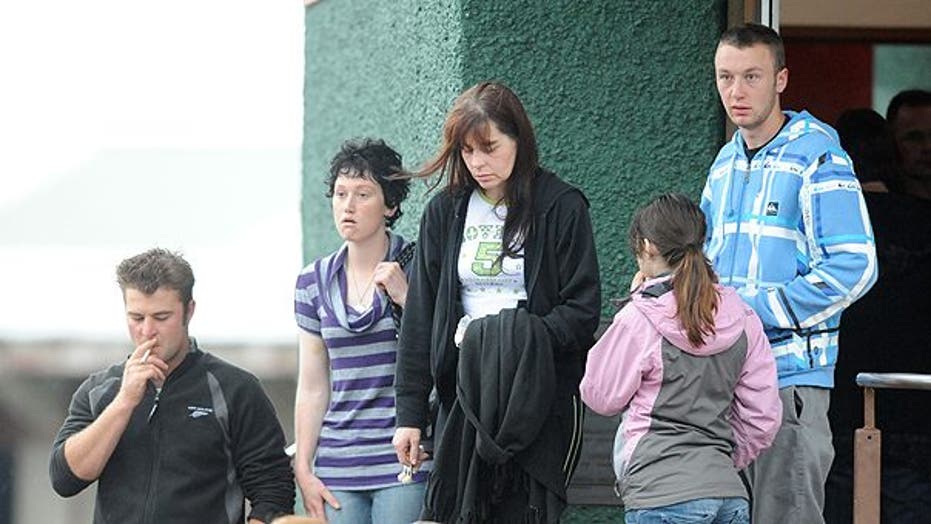GREYMOUTH, New Zealand -- Rescue officials on Monday were preparing to send a high-tech robot into a mine tunnel to transmit pictures and assess toxic gas levels three days after an explosion left 29 miners missing underground.
Police superintendent Gary Knowles, the rescue controller, said the New Zealand defense department had upgraded the robot so it would not create a spark and accidentally ignite a fresh explosion in the mine, near Atarau on South Island.
But they were still waiting for gas conditions to stabilize further before sending the robot in, Knowles said.
The dangerous gases and underground heat have kept rescue teams from entering the mine ever since the Friday afternoon blast, and there has been no communication with the 29 missing men.
Fresh air was being pumped down an open air line, but gas levels were still fluctuating wildly, authorities said.
"The situation remains grave, given we've had no contact from the men for more than three days," Knowles told reporters Monday.
"We remain optimistic," he said. "This is a search and rescue operation. We're basically going to go in there and bring these guys out."
The robot will be able to provide pictures and gas samples up to a mile (1,500 meters) into the mine's main tunnel. Knowles said that would give rescuers an idea of how safe the route is and whether they can enter themselves.
Police have said the miners, aged 17 to 62, are believed to be about 1.2 miles (two kilometers) down the tunnel.
Each miner carried 30 minutes of oxygen, and more stored in the mine, along with food and water, could allow several days of survival.
The mine is entered through a 1.4-mile (2.3-kilometer) horizontal tunnel into the mountain, and the coal seam lies about 650 feet (200 meters) beneath the surface.
Experts are also drilling a six-inch (15-centimeter) -wide shaft down from the surface to the mine tunnel to assess air quality and to lower listening devices. The drill was expected to break through the tunnel roof later Monday.
One of two workers who escaped from the mine described the explosion as "a shotgun blast, but much, much louder and more powerful." Daniel Rockhouse, 24, was smashed into the mine wall before collapsing amid the smoky, swirling gas and dust.
When he came to, Rockhouse dragged himself upright and staggered to a nearby compressed air line to breathe in fresh air and gain some strength.
"I got up and there was thick white smoke everywhere -- worse than a fire. I knew straight away that it was carbon monoxide," Rockhouse, whose brother Ben remains underground, told the New Zealand Herald newspaper in its Monday edition.
"I couldn't see anything, and it was dead quiet," he said. "I yelled, 'Help, somebody help me!' But no one came. There was no one there."
He eventually stumbled across the unconscious body of Russell Smith, and dragged him until he awoke. The two men relied on the compressed air line as they stumbled through the dark haze to finally reach the surface nearly two hours after the explosion.
"It wasn't just a bang, finish, it just kept coming, kept coming, kept coming, so I crouched down as low as I could in the seat and tried to get behind this metal door, to stop getting pelted with all this debris," Smith told New Zealand's TV3.
"I remember struggling for breath. I thought at the time it was gas, but ... it was dust, stone dust, I just couldn't breathe. And that's the last I remember," he said.
Both men were treated for minor injuries and released from the hospital.
New Zealand's mining sector is generally safe. In China -- which has the world's deadliest mines -- water flooded a small coal mine Sunday, trapping 28 workers, officials said. Thirteen workers escaped and rescue work continued for the missing men.
Smith said he couldn't help worrying about his colleagues still underground.
"There's a lot of young guys down there. A lot of people waiting," he said. "Whether they're still alive or dead or ... in an air pocket, you just don't know, because we're not too sure where the explosion was."
Officials believe the blast was most likely caused by coal gas igniting. An electricity failure shortly before the explosion may have caused ventilation problems that let gas build up.
The miners' union said Sunday there had been no previous safety issues at the mine.
"As far as I know, there had been pretty standard procedures in place and nothing ... that would have pointed to a potential risk was raised by workers," Andrew Little, spokesman for the Engineering, Printing and Manufacturing Union, told reporters.
Australian and British citizens were among the missing men, and Australia sent a team of mine rescue experts to assist the operation.
The 2-year-old Pike River mine is working the largest-known deposit of hard coking coal in New Zealand, about 58.5 million tons.
A total of 181 people have been killed in New Zealand's mines in 114 years. The worst disaster was in March 1896, when 65 died in a gas explosion. Friday's explosion occurred in the same coal seam.
The Pike River coal mine differs from the Chilean gold and copper mine where 33 men were rescued after being trapped 69 days. Methane gas was not a concern at the Chilean mine, but its only access shaft was blocked, while the Pike River mine has two exits.

